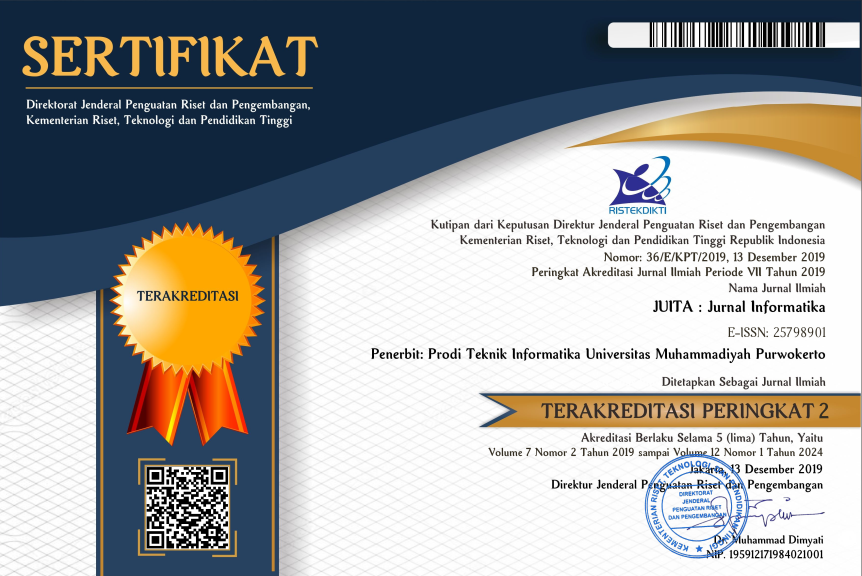Multiplayer Game Guessing Sunda’s Proverb Using Socket.Io And Node.Js
Abstract
Game development is currently quite rapid. Now games can be played by various groups, because many games now contain not just games, but there are also games with educational content. The educational game that will be made in this study is a website-based Sundanese proverb game, this type of game will be multiplayer so that players can compete with other players. The purpose of this research is to make a Sundanese proverb educational multiplayer game that can be played simultaneously with many players, so that it can introduce the regional language, namely Sundanese, to the wider community. The technology used in making this game is Socket.IO and Node.JS, using these technologies can make end users interact in real time. In making this game using the Game Development Life Cycle (GDLC) methodology with the stages of initialization, pre-production, production, testing, beta and release. The results obtained in this research are website-based Sundanese proverb educational games that can be used without taking up much space on the device.
Keywords
References
[1] A. Sutisna, “Aspek Tatakrama Masyarakat Sunda Dalam Babasan Dan Paribasa,” Lokabasa, vol. 6, no. 1, 2015, doi: 10.17509/jlb.v6i1.3137.
[2] H. S. Nugraha, “Peribahasa Sunda (Kajian Struktur, Semantik, dan Psikolinguistik),” Lokabasa, vol. 4, no. 1, 2013, doi: 10.17509/jlb.v4i1.3112.
[3] E. Logita, “MAKNA DAN FUNGSI PARIBASA SUNDA (PANGJURUNG LAKU HADÉ),” Bahtera Indones. J. Penelit. Bhs. dan Sastra Indones., vol. 3, no. 2, pp. 54–66, 2018, doi: 10.31943/bi.v3i2.14.
[4] T. H. Laine and R. S. Lindberg, “Designing engaging games for education: A systematic literature review on game motivators and design principles,” IEEE Trans. Learn. Technol., vol. 13, no. 4, pp. 804–821, 2020, doi: 10.1109/TLT.2020.3018503.
[5] E. Guardiola, Gameplay Definition: A Game Design Perspective. 2019.
[6] Pratama, I. P. A. E. and I. W. G. Arisna, “FIGHTER PLANE ONLINE GAME BASED ON DESIGN SCIENCE RESEARCH METHODOLOGY USING SOCKET. IO AND NODEJS,” Indones. J. Eng. Sci., vol. 3, no. 2, pp. 029–037, 2022, doi: 10.51630/ijes.v3i2.38.
[7] Y. V. Singh, H. Singh, and J. K. Chauhan, “Online Collaborative Text Editor Using Socket. IO,” 2021 3rd Int. Conf. Adv. Comput. Commun. Control Netw., pp. 1251–1253, 2021, doi: 10.1109/ICAC3N53548.2021.9725782.
[8] D. Tresnawati and D. S. A. Wardi, “Rancang Bangun Aplikasi Game Teka Teki Silang Peribahasa Bahasa Sunda,” J. Algoritm., vol. 17, no. 2, pp. 553–560, 2020, doi: 10.33364/algoritma/v.17-2.553.
[9] A. G. I. Hutabarat and A. C. Padmasari, “Rancang Bangun Game Tradisional ‘Tambah Satu’ berbasis Platform Android,” J. Pendidik. Multimed. Edsence, vol. 2, no. 1, pp. 29–44, 2020, doi: 10.17509/edsence.v2i1.25028.
[10] M. A. Wibowo, I. M. A. Suyadnya, and K. O. Saputra, “RANCANG BANGUN APLIKASI GAME MULTIPLAYER SEBAGAI ALAT BANTU PROSES PEMBELAJARAN BERBASIS WEBSOCKET,” J. SPEKTRUM, vol. 8, no. 3, pp. 120–127, 2021, doi: 10.24843/SPEKTRUM.2021.v08.i03.p15.
[11] P. R. Hijjah, “DESIGN OF NETWORKED MULTIPLAYER SNAKE AND LADDER EDUCATIONAL GAME BASED ON HASH MAP AND VECTOR DATA STRUCTURE,” JUITA J. Inform., vol. 8, no. 2, pp. 159–168, 2020, doi: 10.30595/juita.v8i2.8436.
[12] J. Budiman, W. Wirijadipura, M. H. Widianto, S. A. Qonitatin, and A. R. Pramudya, “Design and Development of ‘Fright Hour’ A Horror Game Utilizing Unreal Engine 5,” 2022 8th Int. Conf. Educ. Technol. (, pp. 123–129, doi: 10.1109/ICET56879.2022.9990769.
[13] F. P. Albahri, “Scratch Quiz Game Development using AppsGeyser,” Int. J. Softw. Eng. Comput. Sci., vol. 2, no. 2, pp. 39–45, 2022, doi: 10.35870/ijsecs.v2i2.797.
[14] L. Fitriani, S. Dianti, D. Kurniadi, A. Mulyani, and R. Setiawan, “Mapping-Based Using Geographic Information Systems for Smart Transportation,” in in 2021 International Conference on ICT for Smart Society (ICISS), 2021, pp. 1–5, doi: 10.1109/ICISS53185.2021.9533202.
[15] B. Pasaribu, Y. Latief, and S. Riantini L, “Development of Risk-Based Standardized Work Breakdown Structure (WBS) to Improve Quality Planning of Drainage Construction Work Development of Risk-Based Standardized Work Breakdown Structure (WBS) to,” IOP Conf. Ser. Earth Environ. Sci., vol. 258, no. 1, p. 12054, 2019, doi: 10.1088/1755-1315/258/1/012054.
DOI: 10.30595/juita.v11i2.16828
Refbacks
- There are currently no refbacks.

This work is licensed under a Creative Commons Attribution 4.0 International License.
ISSN: 2579-8901
- Visitor Stats
View JUITA Stats










